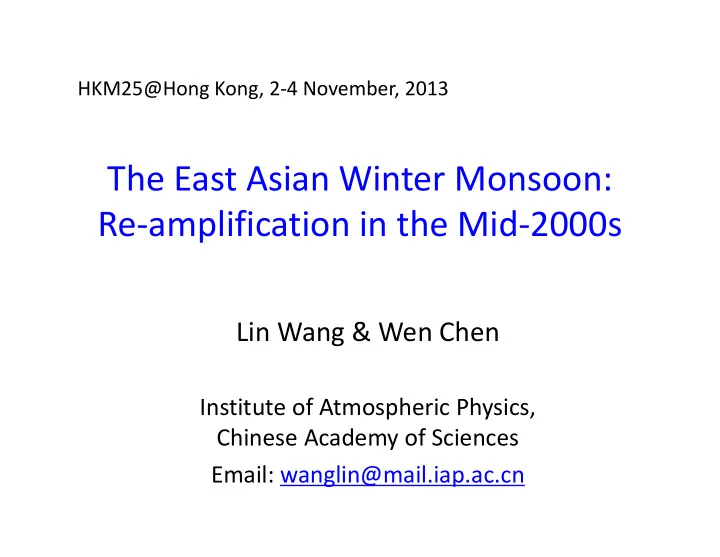

HKM25@Hong Kong, 2-4 November, 2013 The East Asian Winter Monsoon: Re-amplification in the Mid-2000s Lin Wang & Wen Chen Institute of Atmospheric Physics, Chinese Academy of Sciences Email: wanglin@mail.iap.ac.cn
Outline • Introduction • A new intensity index for the EAWM • Re-amplification of the EAWM in the mid- 2000s and its possible causes • Conclusion
1. Introduction The East Asian winter monsoon (EAWM) DJF mean SLP and 10-m wind
Severe winters in recent years instrument shelter ~3m Does strong EAWM epoch come back 2008/01 Nanyue, China 2006/01/07 Tsunan, Japan again after the weakening around 1986? 2013/02/17 Nanjing, China 2013/01/14 Tokyo, Japan
2. The new EAWM index Aleutian Aleutian Siberian Siberian Low (AL) Low (AL) High (SH) High (SH) Climatology of Maritime Maritime Continent Continent DJF mean SLP Low (MCL) Low (MCL) • The thermal (hence SLP) contrast between Asian continent and adjacent oceans is a primary nature of the EAWM. • East-west & North-south SLP gradient are both important! – Strong EAWM-> high SLP over SH, low SLP over MC due to more convection-> enhanced north-south SLP gradient • Advantages of defining EAWM with SLP: – Reflect the nature of monsoon – Reliable to investigate the historical EAWM variations
Aleutian Aleutian Siberian Siberian Low (AL) Low (AL) High (SH) High (SH) 1 2 Climatology Maritime Maritime Continent Continent 3 Low (MCL) Low (MCL) *: normalization *: normalization Interannual standard deviation
ERA-40 dataset 1957/58-2001/02 Selected strong/weak winters for composite (+/- 0.5 sigma). El Nino La Nina (16) (16)
Composite of circulation anomalies strong-weak EAWM winters SLP H500 U200 850 hPa wind
Composite of Ts & rainfall anomalies strong-weak EAWM winters Rainfall Ts PREC ERA40 160 China 160 China stations stations
ERA40 data No. of warm No. of warm Corr. Coeff. winters in winters in New index weak EAWM weak EAWM years years No. of cold No. of cold winters in winters in strong strong EAWM year EAWM year X-axis : EAWM index Y-axis : East Asian SAT New index ranks No. 2 in correlation coefficient (0.77 vs 0.78), and No. 1 in describing the extreme winters. Besides, it has better predictability, as will be shown later.
Station data No. of warm No. of warm Corr. Coeff. winters in winters in New index weak EAWM weak EAWM years years No. of cold No. of cold winters in winters in strong strong The new index has good ability to EAWM year EAWM year describe the EAWM-related circulation X-axis : EAWM index Y-axis : 160-station SAT and temperature/rainfall features For station data, we can get similar conclusion regarding correlation coefficient (No. 2, 0.67 vs 0.71) and extreme years (No. 1, 9/10 vs 9/8, especially for strong EAWM).
SST anomalies strong-weak EAWM winters -SON DJF +MAM +JJA
Lag correlation with oceanic indices The tropical The tropical Indian Ocean SST Indian Ocean SST seems to exert seems to exert more impacts on more impacts on the EAWM than the EAWM than ENSO does, ENSO does, especially when especially when Tropical Indian Ocean may provide SST leads EAWM SST leads EAWM additional prediction potential for the by one and zero by one and zero month. month. EAWM besides ENSO ** 99.9%, * 99%
Predictability of the index in DEMETER CGCMs Three models were used. • • Nine runs in each model. • Prediction started from November (1 month lead) Data periods: 1958/59-2001/02 • SCWF CNRM UKMO **99.9% (ECMWF) (Météo-France) (UK Met Office) New index -0.07 0.52** 0.22 French model did a good job, consistent with Li • and Wang (2012). Possible reason of success (failure): The EAWM- • tropical ocean relationship was (was not) reasonably reproduced in the model.
SCWF CNRM UKMO Predictability of all the EAWM * 99% (ECMWF) (Météo-France) (UK Met Office) indices in DEMETER CGCMs **99.9% New index -0.07 0.52** 0.22 Our index ranks No.3 Guo (1994) 0.00 0.31 -0.27 Shi (1996) 0.00 0.36 0.02 SLP contrast Wu & Wang (2002) -0.04 0.31 -0.11 indices Chan & Li (2004) -0.06 0.22 -0.28 Wang et al. (2009b) -0.04 0.16 -0.19 Low-level v-wind indices Chen et al. (2000) 0.61** 0.67** 0.58** are best predicted Hu et al. (2000) 0.49** 0.65** 0.50** Zhu (2008) -0.09 0.36 0.00 Upper u-wind Li & Yang (2010 0.21 0.39* 0.15 shear indices Cui & Sun (1999) 0.09 0.46* 0.29 Mid-tropospheric Sun & Li (1997) -0.01 0.48* 0.29 trough indices Wang et al. (2009a) 0.18 -0.16 -0.21
3. Re-amplification of the EAWM EAWM index for DJF of 1957/58-2012/13
7 out of 9 winters feature strong EAWM for 2004/05-2012/13 The index indicates a decadal EAWM index for DJF of 1957/58-2012/13 amplification of the EAWM
Area-averaged Ts over East Asia Ts confirms that the EAWM 7 out of 9 winters feature cold Ts for 2004/05-2012/13 entered strong epoch since 2004 ---Possible cause?
Previous strong Previous strong Recent strong Recent strong EAWM epoch EAWM epoch EAWM epoch EAWM epoch 1976-1987 1976-1987 2004-2012 2004-2012 Ts Ts AO-like pattern AO-like pattern Somewhat AO-like, Somewhat AO-like, is responsible is responsible but not typical but not typical SLP SLP Ural blocking is Ural blocking is clear all the time clear all the time H500 H500
Blocking frequency over Ural (50-80E) region Strong Strong Weak Enhanced Ural blocking is responsible for the recent Longitudinal distribution of blocking frequency amplification of the EAWM
External forcing? Maybe diminished Arctic sea ice Less autumn Arctic sea ice ->More wintertime blocking The physical process needs be studied in the future.
4. Summary • A new EAWM index was proposed by taking into account the north-south SLP gradient. The performance of the new index is good. • The EAWM re-amplified since the mid-2000s. • The Enhanced Ural blocking and diminished Arctic sea ice are responsible for this re- amplification. ���������� • For details: – Wang and Chen (2013a, J. Climate, minor revision) – Wang and Chen (2013b, Chinese Sci. Bull., in press)
SON mean snow depth
DJF mean snow depth
Recommend
More recommend